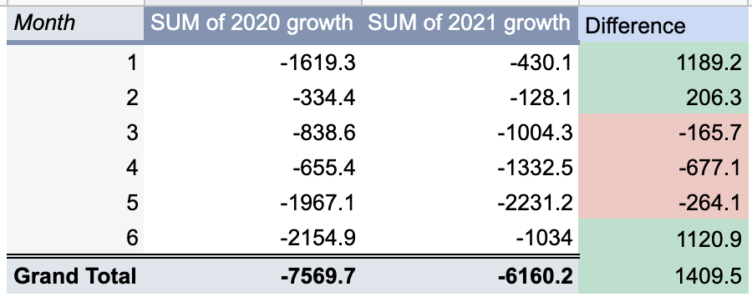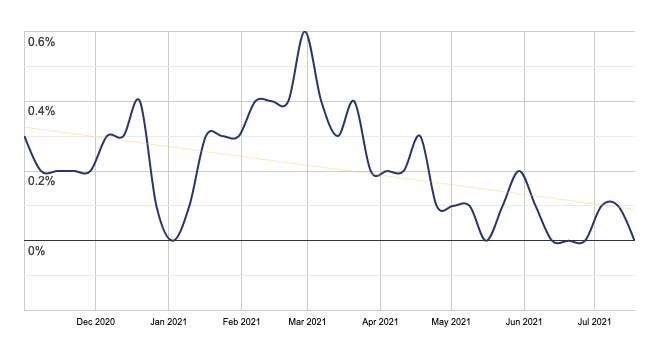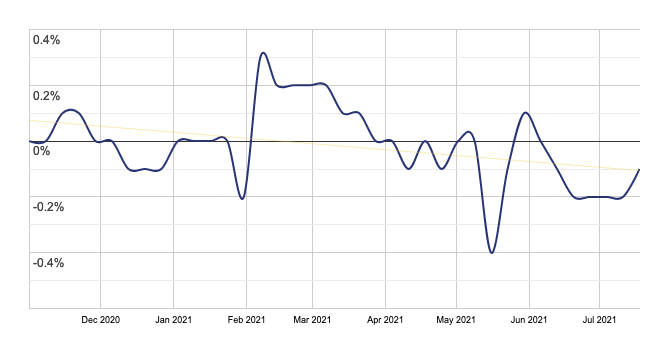Along with some other people, I have been intensely watching the active install growth charts on the WordPress.org plugin repository for a variety of plugins for the past few months. Since I’m involved with several different plugins to various degrees (mainly Envira Gallery Lite, NextGen Gallery, and Soliloquy Lite) this project started out of curiosity and self-interest.
Monitoring these plugins and others off and on over the past year — since the early days of the pandemic — often we could see stable growth and more than a few times respectable gains in the active install statistics on WordPess.org. However, since about May or early June, the overall trends for some of the most popular and well-known plugins’ “active install growth” (as reported by WordPress.org) are pointing generally downward — growth is in decline. In some plugins we see negative percentages, which seems to suggest the plugins are being removed from WordPress sites.
The Plugins We Monitored
In addition to my own, the following plugins are the ones I focused on, and most of these exist under the “most popular” category on WordPress.org:
- Jetpack
- Yoast SEO
- Elementor
- Classic Editor
- WooCommerce
- WPForms
- Monster Insights
- Contact Form 7
- Advanced Custom Fields
- Regenerate Thumbnails
- Google Site Kit
- Yoast Duplicate Post
- OptinMonster
- Ninja Forms
- Rank Math
- Envira Gallery
“I doubt the explanation for the decline of active installs is single and simple.”
David Bisset
These plugins represent a diverse group from the plugin repository. Some are small plugins that do one job, others are the free version of a plugin that offers a commercial version. They range from developer-favored plugins to ones almost anyone with a new WordPress site would be likely to install.
Of course, exact numbers and the hills and valleys of active install stats differ from plugin to plugin. But overall, if you look at charts as a whole you’ll see a general dropoff around the month of April. Some drop into negative territory, and others don’t. Some have had peaks since that time, but the trend appears to be less or negative growth since April compared to the first three months of 2021.
I will note some of these plugins are seeing slight upticks very recently, but it’s too soon to tell what that might mean.
Getting More Data
I reached out to Iain Poulson, who recently sold Plugin Rank to Awesome Motive and who keeps track of plugin trends with his WP Trends newsletter. Iain has more experience, knowledge, and data than me so I thought I would ask him about the apparent downward trend in active installs.
According to Iain, growth for plugins found in WordPress.org’s “Popular” category (at least the ones I sampled) seems to be generally up for the first half of 2021 versus the first half of 2020. Despite a slight dip in March and April 2021, these plugins are growing. That isn’t surprising as they are popular plugins for a reason. The WordPress.org plugin directory search algorithm makes plugins with large active install numbers feature higher in search results than others, which to some degree perpetuates their popularity.
However, taking additional data into account by looking at over 1000 plugins for the same period, overall there does seem to be a dip from March to May 2021. This confirms what we have been seeing in the charts on WordPress.org.

What Does This Mean?
Since WordPress itself experienced growth that hasn’t slowed since last year, what is driving these active plugin installation numbers down suddenly? Assuming the statistical reporting itself hasn’t changed, it is an unprecedented trend.
I doubt the explanation for the decline of active installs is single and simple. But since this is happening to a wide variety of plugins, Iain and the other people I shared my observations with had at least one common theory that makes sense: this is a reaction to the huge amount of growth we saw last year.
As Iain put it, “I think it is more that the growth was higher when everyone was building sites and taking everything online during the pandemic, and this is the inevitable decline in growth.”
“[G]rowth was higher when everyone was building sites and taking everything online during the pandemic, and this is the inevitable decline in growth.”
Iain Poulson
In terms of sales, I have (in confidence) reached out to some WordPress plugin developers that mostly do not have plugins in the “Popular Plugins” category in the repo. They have acknowledged that their overall sales are matching the recent trends. Sales have been in decline. There are not enough data points to be conclusive, so I would be very open to talking with other business owners of pro plugins and services what they have seen in the last three months. Contact me on Slack or via the Post Status form.
With vaccinations and restrictions being lifted, people are starting to get out more which might lead to less time with business and personal projects.
There’s no reason to panic but plugin authors and business owners should be aware of the trend and keep an eye on it. I think the sudden dip is what caught my (and others) eye. While noteworthy the ecosystem could be “adjusting” as other industries are going through similar trends.
It’s clear that WordPress itself continues to grow and along with it the community is strong, thriving, and getting more so by the day. Active install numbers are just one metric. It will be interesting to see where that metric goes in the next few months — will this prove to be simply a reversion to the mean after the boom of 2020.
Bottom Line: If you a small business or a solo developer with plugins that have a small user base, you might be feeling a dip right now this year than the bigger and “more popular” plugins. 🔌


















Not that I reflect the bulk of users but personally I’ve been removing a lot of these plugins from all my client sites because they’ve become so bulky and bloated. Jetpack, for example, is one that avoid as much as I can and I’m currently in the midst of experimenting with alternatives for WooCommerce for the same reason – Automattic’s plugins all either max out my PHP workers or include a million features that other plugins do better. Yoast, Ninja Forms, Monster Insights, Envira, etc., all great plugins but when all of them are installed there’s just too much going on. It also wouldn’t surprise me if a lot of WP’s growth during the pandemic was from people who were ‘trying their hand’ at building a website and aren’t as aware of the big players in the plugin ecosystem.
> It’s clear that WordPress itself continues to grow
I am starting to wonder if the community should begin tracking other metrics to better understand the true health of WordPress. We tend to lean quite heavily on the w3techs stat (currently 42.2% of CMS powered sites) but other tools are telling a different story.
Google trends for example shows a decline in WordPress interest that has been ongoing for 5 years (https://trends.google.com/trends/explore?date=today%205-y&q=%2Fm%2F02vtpl,wordpress,%2Fm%2F089vdb) and Builtwith.com is also showing that WordPress hit a peak in the last 12 months or so.
I am actively removing Jetpack from sites I manage. It’s too big and bloated now. It’s UI and requirement for a wp.com account are too confusing.
I’m actively removing Contact form 7 too. It used to be my go to default on the simplest sites, now I use Ninja forms (though I may rethink that).
Finally, I am looking for an alternative to Next gen gallery. Simply because I cannot update it (and the pro add-ons) with standard remote management tools. I think it is one of the best, but a non standard update process when you manage 100+ sites is not acceptable.
Hey Mike,
Thanks for sharing your reasoning! I work at Imagely, which makes NextGEN Gallery. I wanted to chime in and share that we are in fact moving the updater we have in our premium plugins move to the default WP updater. That’s in process and should be done in one of the next updates. Unfortunately, an update with the existing updater will be required in order to get to the new version with the change (once released).
HI! Steve Teare from PagePipe. We save the internet from WordPress abuse. So here are some opinions: #1: Gutenberg block editor adoption is reducing the need to add plugins for features. #2: The need for speed (as mentioned in above comments). #3: Market confusion from too many choices. #4: We suspect Covid recovery also means few people are working on their sites and out interacting with real people live and in person. #5: Confusion from panic over Google Core Web Values, in the end, not making any ranking difference. “What do I do now?”
Those are some of our speculations about plugin decline.